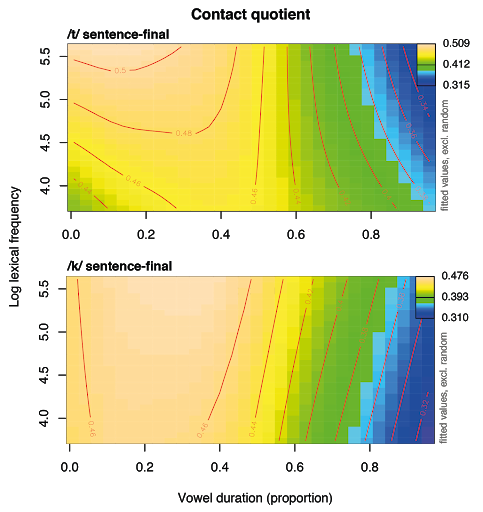The effect of lexical frequency on vowel phonation as a correlate of /t/-glottaling {S Coretta, M Canzi}
September 13, 2018 - 4 minutes
acoustics egg phonetics productionOutput
- (2018) Coretta, S. & Canzi, M. The effect of lexical frequency on vowel phonation as a correlate of /t/-glottaling. Talk presented at the Linguistic Association of Great Britain (LAGB) conference at the University of Sheffield.
Abstract
Introduction. Lexical frequency is known to modulate the effects of a phonetic bias on speech production, such that high-frequency words show a stronger effect for a particular bias since they are exposed more often to that bias (Bybee 2004). A prediction of this account is that the degree of anticipatory glottalisation from a glottalised consonant to a preceding vowel should be greater in high-frequency words than in low-frequency words, given the greater exposure to glottalisation. Such effect should be magnified in sentence-final position, for which more glottalisation has been shown to be present (in American English, Abdelli-Beruh et al. 2014). Such predictions are put to test in a pilot study which focuses on vowel anticipatory glottalisation from a glottal stop, which is the outcome of /t/-glottaling (by which /t/ is substituted with [ʔ], Bermúdez-Otero et al. 2016). We show that, contrary to prediction, low-frequency words are creakier and that phonation in sentence-final position is breathier.
Methods. Synchronised audio and electroglottographic (EGG) data were recorded from 2 speakers of Manchester English. EGG is a non-invasive technique that enables the estimation of the amount of vocal folds contact by means of changes in electrical impedance of a current passing through the neck (Fabre 1957, Herbst 2014). The participants read carrier sentences containing target words either in sentence-medial (Say X again) or sentence-final position (The word is X). 32 target words ending in either /t/ or /k/ forming minimal pairs were chosen, while controlling for log lexical frequency (range: 3.16-5.61) and vowel (/æ, ɪ, ɔː, ʌ/) using values from SUBTLEX-UK (Van Heuven et al. 2014). Participants were asked to glottalise /t/ throughout the reading task. The sentences with the target words were presented 3 times each in a randomised order with PsychoPy (Pierce 2009). The method by Henrich et al. 2005 was used for extracting the contact quotient (CQ) trajectories within the vowel duration. The CQ is a measure of vocal folds contact as the ratio of fold contact within a single vibratory cycle. Higher values of the CQ indicate creakier phonation, while lower values are typical of breathier voice (Rothenberg 1988). Generalised additive mixed models (GAMMs, Wood 2006) were used to assess differences in CQ trajectories.
Results. According to GAMMs, the CQ decreases during the vowel in every context. This means that phonation increasingly becomes breathier. Lexical frequency has a significant effect, which diverges depending on the identity of the consonant (/t, k/). In the context of /t/, the magnitude of the decrease is higher in high-frequency words than in low-frequency words (phonation becomes breathier earlier within the vowel in high-frequency than in low-frequency words). However, in the context of /k/, vowels in low-frequency words are characterised by an early change to a breathier phonation, a pattern that is the opposite of that of vowels followed by /t/. Moreover, the effect of decreasing CQ (i.e. change to breathier phonation) is stronger in sentence-final than in sentence-medial position, such that vowel of sentence-final words get breathier earlier within their duration than vowels in sentence-medial words.
Discussion. Although to be confirmed with data from more participants, the patterns emerged in this exploratory study bring up possible theoretical issues concerning the diachronic trajectory of /t/-glottaling and its present state. The results we obtained are in agreement with the proposal by Bermúdez-Otero et al. 2016 that the /t/-glottaling sound change has reached completion in Manchester. If this is the case, our results might indicate that a new sound change would be in progress now, namely the change to breathier phonation. On the other hand, if the sound change has not yet reached completion, a viable interpretation of our results is that, diachronically, low-frequency words rather than high-frequency words were leading (contra Bermúdez-Otero et al. 2016), and hence the former were subject to greater glottalisation (cf. Hay et al. 2015). Finally, considered the almost nominal rate of glottalisation in our data, the decoupling of vowel glottalisation from the application of /t/-glottaling could shed light on how timing of laryngeal gestures are represented in the lexicon.

Figures 1 and 2. Estimates from the GAMM showing contact quotient (z-axis) within vowel duration (x-axis) as a function of lexical-frequency (y-axis) in sentence-final words. Lower CQ indicates breathier phonation. For /t/ (top plot), the higher the lexical frequency, the earlier in the vowel phonation changes to breathy (blue portion of the heatmap). The bottom plot shows that the opposite pattern is found for /k/, where vowels become breathier earlier in low-frequency words.
Resources
You can find the research compendium (including data, analysis, code and slides/poster) for the project at the following link: